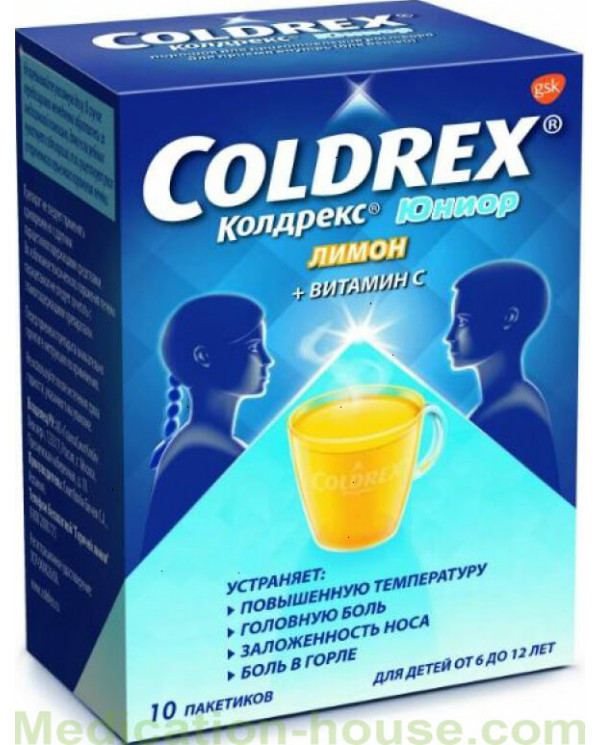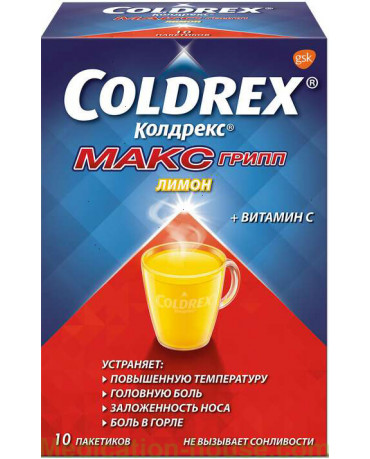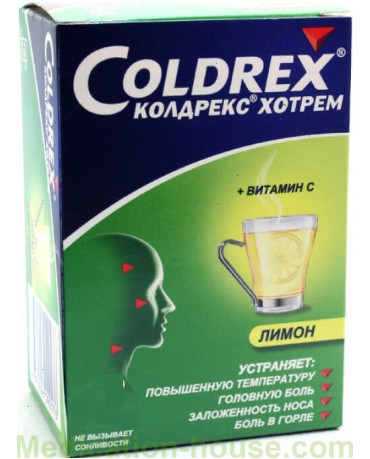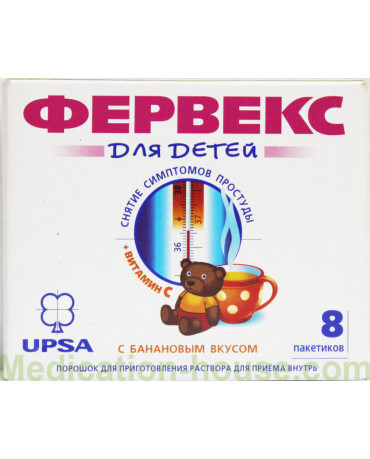Coldrex Junior instruction for use
Reed more and buy Coldrex Junior on this page
Indications for use
To eliminate the symptoms of acute respiratory infections and influenza in children aged 6-12 years, including:
- increased body temperature;
- headache;
- chills;
- pain in the joints and muscles;
- nasal congestion;
- Pain in the sinuses of the nose and throat.
Contraindications
Coldrex Junior should not be taken simultaneously with other paracetamol-containing drugs, with increased sensitivity to the ingredients that make up the drug, with a genetic absence of glucose-6-phosphate dehydrogenase, with diseases of the blood system, with severe violations of the liver or kidneys, thyrotoxicosis, diabetes, arterial hypertension, heart disease (severe stenosis of the aortic orifice, acute myocardial infarction, tachyarrhythmia); angle-closure glaucoma in children under 6 years old.
Used with caution in benign hyperbilirubinemia.
How to use: dosage and course of treatment
Pour the contents of 1 sachet into a mug, pour about 125 ml of hot water, stir until dissolved. If necessary, add cold water and sugar.
Children from 6 to 12 years: 1 sachet every 4 hours. Do not take more than 4 sachets within 24 hours. Do not give the drug to children under 6 years without consulting a doctor.
Coldrex Junior is not recommended for use for more than five days without consulting a doctor. If symptoms persist, consult a doctor.
Do not exceed the indicated dose. In case of overdose, seek medical attention immediately, even if the child is feeling well, as there is a risk of delayed serious liver damage.
pharmachologic effect
Coldrex Junior is a combined drug.
Paracetamol has an antipyretic, analgesic effect.
Phenylephrine hydrochloride - reduces swelling of the mucous membranes of the sinuses of the nose, which facilitates nasal breathing.
Ascorbic acid makes up for the increased need for vitamin C for colds and flu.
Side effects
In recommended doses, the drug is usually well tolerated.
Paracetamol rarely has a side effect. Allergic reactions are sometimes possible, for example, skin rash, urticaria, angioedema. Rarely - thrombocytopenia, leukopenia, agranulocytosis. With prolonged use in excess of the recommended dose, hepatotoxic and nephrotoxic effects may be observed.
Phenylephrine can cause nausea, headache, a slight increase in blood pressure, and in rare cases, palpitations that occur after drug withdrawal.
Signs of an overdose are nausea, vomiting, stomach pain, sweating, pallor of the skin, cardiac arrhythmias. After 1-2 days, signs of liver damage can be determined. In severe cases, liver failure and coma develop.
If you suspect poisoning, you should immediately seek medical help. The victim should be given a gastric lavage during the first 4 hours of poisoning and consult a doctor. A specific antidote for paracetamol poisoning is acetylcysteine.
special instructions
Coldrex Junior should not be taken at the same time as other paracetamol-containing drugs, as well as other non-narcotic analgesics, NSAIDs (metamizole sodium, acetylsalicylic acid, ibuprofen, etc.), drugs to relieve cold symptoms, sympathomimetics, such as decongestants, with appetite-regulating drugs, amphetamine-like psychostimulants, barbiturates, antiepileptic drugs, rifampicin, chloramphenicol. Before taking the drug, you need to consult a doctor in case of taking metoclopramide, domperidone (used to eliminate nausea and vomiting) or colestyramine used to lower blood cholesterol; taking drugs to reduce blood coagulation (e.g., warfarin); adherence to a hyponatrium diet (each bag contains 0.06 g of sodium).
In order to avoid toxic liver damage, the drug should not be combined with preparations containing ethyl alcohol.
When conducting tests to determine uric acid and blood glucose levels, tell your doctor about the use of Coldrex Junior, since the drug may distort the results of laboratory tests that evaluate the concentration of glucose and uric acid.
Coldrex Junior does not cause drowsiness. If dizziness occurs, one should refrain from driving vehicles or other potentially dangerous activities that require an increased concentration of attention and speed of psychomotor reaction.
Interaction
Coldrex Junior should not be taken simultaneously with tricyclic antidepressants, beta-blockers, MAO inhibitors, and within 14 days after their withdrawal.
The risk of developing hepatotoxic effects increases with the simultaneous administration of barbiturates, diphenin, carbamazepine, rifampicin, zidovudine and other inducers of microsomal liver enzymes.
Metoclopramide and domperidone increase the absorption rate of paracetamol, and reduces colestyramine (the doctor determines the need for joint use with Coldrex Junior individually).
Paracetamol reduces the effectiveness of diuretic drugs. When taken for a long time, paracetamol enhances the effect of indirect anticoagulants (warfarin and other coumarins), which increases the risk of bleeding.
Phenylephrine reduces the hypotensive effect of guanethidine, guanethidine enhances the alpha-adrenostimulating effect of phenylephrine.
With simultaneous use, it should be borne in mind that corticosteroids increase the risk of developing glaucoma; Halotane increases the risk of ventricular arrhythmias.
Terms of sell
You can buy Coldrex Junior without a prescription.




